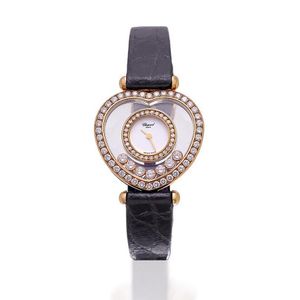18ct Gold Diamond Malachite Bracelet Watch by Omega
You must be a subscriber, and be logged in to view price and dealer details.
Subscribe Now to view actual auction price for this item
When you subscribe, you have the option of setting the currency in which to display prices to $Au, $US, $NZ or Stg.
- Movement - The technical name for the workings of a clock or watch, and does not include the dial or case.
- Bezel - On a clock or watch, the bezel is the metal frame into which the watch or clock glass is fitted. In clocks, the bezel may include a hinge and a flange, in effect a door to the face of the clock. In jewellery the bezel is a band of metal with a projecting lip that holds the gemstone in its setting.
- Circa - A Latin term meaning 'about', often used in the antique trade to give an approximate date for the piece, usually considered to be five years on either side of the circa year. Thus, circa 1900 means the piece was made about 1900, probably between 1895 and 1905. The expression is sometimes abbreviated to c.1900.
- Malachite - Malachite is bright copper-green coloured stone with concentric layers which displays distinct contrasting veinings. It has been valued in the past for making or decorating small precious objects such as clocks, jewellery, dishes and so. In the Orient it was used for snuff bottles and in Russia and was favoured by the Faberge workshop. larger pieces were used for table tops.
The principal source of supply was Russia but it is to be found in other regions such as Southern Africa, Mexico, Australia and France.
Malachite glass is a manufactured material that was intended to resemble malachite, but often bears more resemblance to a veined coloured marble due to its lower gloss finish and lack of concentric layers. Malachite glass was manufactured by many glassworks in the 19th century including Loetz in Austria and others in Bohemia and Davidson's Greener's and Sowerby in north eastern England.
It was particularly used for scent bottles, bowls, and small vases often decorated with nymphs.
Malachite glass has been manufactured continuously since the late nineteenth century, most is unmarked and it is difficult to distinguish the age or manufacturer of most commercial pieces.
This item has been included into following indexes:
- Omega
Visually similar items

Chopard a lady's 18ct gold and pink diamond and diamond-set heart-shaped wristwatch case ref 20/6602-403 case 490073550 Happy diamonds circa 2010, quartz movement, guilloche dial with five free-floating pink and white diamonds, gilt sword hands, heart-shap

A gentleman's stainless steel wristwatch, Breitling. Quartz. 40 mm, circa 1995. Reference A51038. Case, dial and bracelet signed. Original box.

Rolex, a lady's stainless steel, gold and diamond-set automatic wristwatch with date and bracelet ref 69173 mvt 2528572 case S299263 Datejust circa 1987, cal. 2135 automatic winding movement, 29 jewels, sunburst champagne dial with diamond-set indexes, swe

A lady's Chopard 18ct gold and diamond wristwatch ref 20/5679 case 3811185240 Happy Diamonds circa 2000 Quartz movement, white dial, diamond-set bezel within a diamond-set heart-shaped glazed surround incorporating seven free-floating diamond collets, case
